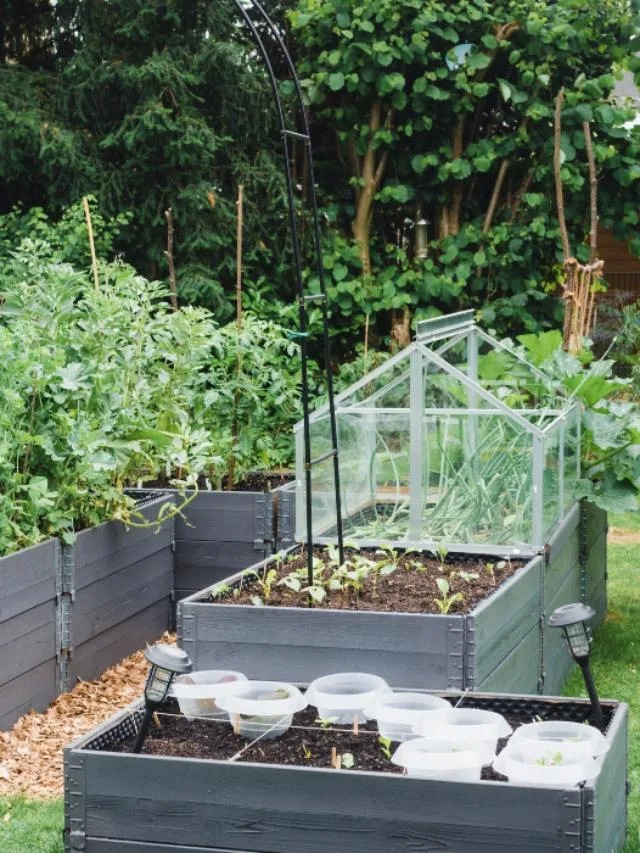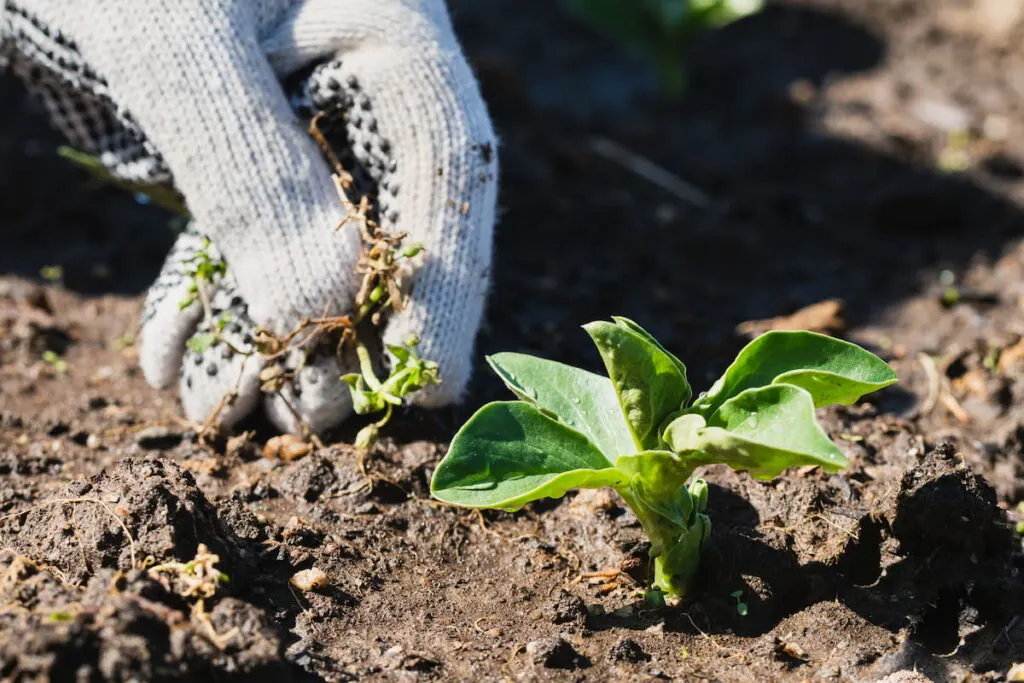It is a great idea to build raised garden beds. Raised garden beds differ in size, appearance, and general design. There isn’t one “right” material or way to construct them. For this post, we’re talking about one of the most common questions asked.
Should you put weed fabric or liners in your raised garden bed?
Weed fabric and weed liners are not necessary for a raised garden bed but they can help you keep soil in and weeds out. While you don’t need one, in most cases it won’t hurt to add them.

Let us discuss the pros and cons of weed fabrics in raised beds, other types of liners, and alternatives to prevent weeds from growing in your raised garden bed.
Table of Contents
What Are Liners?
In horticulture and landscaping, liners are materials acting as a barrier in the soil. Liners can be made of plastic, fabric, cardboard, wood, etc. The intention of installing liners in gardens differ from gardener to gardener.
What Are the Uses of Liners?
Some gardeners install liners in their garden beds while others do not need liners. Here are some uses of liners:
- They trap soil moisture.
- Liners trap heat in the soil.
- They prevent erosion of the soil.
- They prevent the growth of weed.
- They prevent leaching of soil and nutrients.
- Liners prevent pests from your reaching your plants.
Liners are barriers between different layers in the soil, in the sides of garden beds, or between the soil and atmosphere. When used properly, liners give gardeners an easier experience and better yield.
Liners in Raised Garden Beds
Raised garden beds are necessary when growing crops in urban areas, or when you have limited space.
Even though raised garden beds are easy to construct and maintain, it is not so easy to install liners when the raised bed has already been constructed. If you want liners in your raised garden bed, it is easier to install them during the construction of your raised garden bed.
Purpose of Lining the Bottom of a Raised Garden bed
Should we insert liners below our garden beds? What use will a liner below our garden bed have for our vegetables? Here are a few reasons why we should put liners at the bottom of our raised garden beds:
- A major reason why people construct raised garden beds is the prevention of weeds. If there is no liner below our garden beds, weeds (from the soil below) can grow in our raised garden beds.
- If you live in an area disturbed by moles and gophers, the vegetables in your raised garden beds will have better chances of surviving because liners prevent pests from reaching them.
- Most people use special mix (like the addition of compost, mulch, slow-release fertilizer, etc.) in their raised garden beds. Without liners, nutrients in the raised garden beds can leach into the soil below.
Purpose of Lining the Sides of a Raised Garden Bed

Now that we know why we should install weed barriers below our raised beds, another question you might ask is: “Should liners be installed on the sides of a raised bed?”
A few reasons why liners should be installed in the sides of your raised garden bed are:
- When rain falls, or when you water your vegetables in your raised garden bed, some soil and nutrients can leach away with the water. Liners prevent soil from leaching away with water.
- If you made the raised garden bed with a decomposable material (like wood), liners must be installed on the sides. Constant watering deteriorates wood quickly, so liners (e.g. liners
- If you do not put liners in the sides, the roots of your plants might poke out of the raised garden beds.
Types of Weed Control Liners
There are various kinds of liners. Some of them are:
- Plastic
- Cardboard
- Weed Fabric
- Garbage bags
- Old Newspapers
- Natural barriers like a thick layer of leaves, mulch, peat moss, etc.
Some liners stated above like old newspapers, natural barriers, etc. decompose quickly and also produce extra nutrients for your plants. Others like plastics, weed fabric, etc. are more lasting and generally more effective.
We will focus more on weed fabrics in this article.
Weed Fabrics
Weed fabric is a type of liner that is made with woven cotton or other fabric materials. Weed fabrics allow drainage of water through their tiny pores while trapping the heat and moisture of the soil.
Pros and Cons of Using Weed Fabrics in the Garden
Pros of using weed fabrics:
- They act as insulators in the soil
- Weed fabrics last longer than other lining materials.
- Weed fabrics drain water faster than other lining materials.
- Like other liners, weed fabrics prevent weed below from sprouting.
Cons of using weed fabrics:
- Quality weed fabrics are expensive.
- In time, weed will grow above the liner.
- The roots of plants get tangled with the fabric in time.
- Vegetable roots that grow long vertically will be obstructed.
- Weed fabrics prevent Earthworms from reaching the surface from below.
It is your choice to install weed fabrics or other liners in your garden beds. This leads to another common question.
Are liners needed in elevated garden beds (i.e. raised garden beds on legs)? If liners are needed in elevated garden beds, what is the best lining material?
What to Put on the Bottom of an Elevated Garden Bed (Raised Bed on Legs)
Elevated garden beds make your home or garden beautiful. The beauty of elevated garden beds does not last long if you do not use the right lining material.
Wood is the most common material used in making elevated garden beds. Wood degrades quickly when it is exposed to conditions like constant moisture, fungal/bacterial activities in the soil, etc.
To prevent the wood used in your elevated garden bed from decomposing quickly, you have to line the bottom and the sides of the elevated garden bed with a material that allows nothing to reach the wood.
Plastic liners are the best for elevated garden beds. Here is why:
- A solid plastic liner is the best material to use as a liner in your elevated garden bed because plastics do not allow water/moisture to pass through them.
- Plastic liners also do not degrade quickly, so they will last long in your elevated garden bed.
If you use a plastic liner, you have to be careful when you water your crops because plastic liners retain water better than other lining materials.
Now you know the best material to use in lining your garden bed. If weed control/prevention is the reason you are installing a liner in your garden bed, what are alternatives to controlling or preventing weeds from growing in your garden bed?
Other Ways to Help Keep Weeds Out of Your Raised Garden Bed
Plant Cover or Creeping Crops

Cover crops are plants grown to block sunlight from reaching weeds. Examples of cover crops are:
- Oats
- Plant Cover
- Crimson clover
- Elephant ear plants.
(Source)
Crawling crops are plants that crawl when growing. The leaves of creeping crops block sunlight from reaching weeds beneath them. Creeping crops include pumpkins, tomatoes, etc.
Use Fresh Soil Mix
If you add old soil to the soil in your garden to your raised bed, you may be adding weed seeds. The seed of weeds is not easy to identify. To get a weed-free garden, use a fresh soil mix.
Bake Your Soil
Experienced gardeners who wish to use old soil in their raised garden beds bake the soil. To bake your soil, you have to heat the soil for 30 minutes, or wait till the temperature of the soil gets to 180°F (82.2°C). The heat from the soil kills the seed of weeds, unwanted microbes, and other pests in the soil.
When the soil becomes cool, you can use it in your raised garden bed.
Pull Weeds Immediately You See Them

Some weeds disperse their seeds by air. As weeds disperse their seeds by air, your raised garden bed can easily get new weed growth. If you see any weed growing in your raised garden bed, pull it off immediately.
If you do not pull out the weeds immediately, they will multiply.
Mind the Space between Your Plants
A reason to make garden beds is growing a lot of vegetables in them even though they are not very big. To prevent weed from growing in your raised garden bed, you have to reduce the space between your vegetables.
When the space between your plants is reduced, leaves of your vegetables will block light from reaching weeds growing underneath.
Final Thoughts
Installing liners in raised garden beds is important. Liners prevent weeds and pests from reaching your crops, liners also retain moisture by trapping water vapor lost by evaporation.
There are different types of liners, and each type of liner has its advantage over others. In an elevated garden bed, you should use a solid plastic liner so that water will not reach the wood used to make the bed.
Other alternatives to prevent weed from growing in your bed include baking the soil, using fresh soil mix, planting cover crops, etc.
Considering everything we have discussed in this article, what liner will you install in the raised garden bed you are constructing? Share your thoughts in the comment section below.
